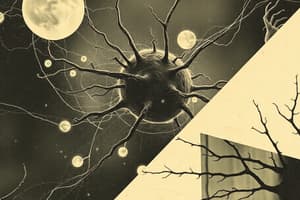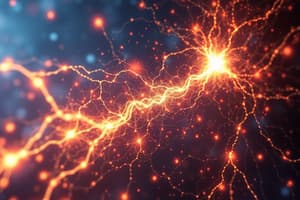Podcast
Questions and Answers
How is an action potential propagated along an axon?
How is an action potential propagated along an axon?
An influx of sodium ions from the current action potential depolarizes the adjacent area.
Why does the action potential only move away from the cell body?
Why does the action potential only move away from the cell body?
The areas that have had the action potential are refractory to a new action potential.
The velocity of the action potential is fastest in which of the following axons?
The velocity of the action potential is fastest in which of the following axons?
- Small myelinated axon (correct)
- Small unmyelinated axon
- Large unmyelinated axon
- Large myelinated axon
The central nervous system, which is composed of the brain and spinal cord, receives and processes information from both the external environment, known as __________ information, and the internal environment, which refers to __________ information.
The central nervous system, which is composed of the brain and spinal cord, receives and processes information from both the external environment, known as __________ information, and the internal environment, which refers to __________ information.
What two divisions of the autonomic nervous system have opposite effects on the organs they innervate?
What two divisions of the autonomic nervous system have opposite effects on the organs they innervate?
What portion of the efferent branch of the nervous system communicates to glands and cardiac muscle?
What portion of the efferent branch of the nervous system communicates to glands and cardiac muscle?
What portion of the efferent nervous system communicates with skeletal muscle?
What portion of the efferent nervous system communicates with skeletal muscle?
What portion of the nervous system provides communication between peripheral organs and the brain and spinal cord?
What portion of the nervous system provides communication between peripheral organs and the brain and spinal cord?
Voltage-gated calcium channels are localized to which part of the neuron?
Voltage-gated calcium channels are localized to which part of the neuron?
On what portion of the neuron do action potentials propagate?
On what portion of the neuron do action potentials propagate?
In a neuron, where is the greatest concentration of voltage-gated sodium and voltage-gated potassium channels?
In a neuron, where is the greatest concentration of voltage-gated sodium and voltage-gated potassium channels?
Which of the following best describes the function of the myelin sheath?
Which of the following best describes the function of the myelin sheath?
The direction of change in membrane potential, in response to a stimulus that initiates a graded potential, is dependent upon:
The direction of change in membrane potential, in response to a stimulus that initiates a graded potential, is dependent upon:
Which statement best describes how graded potentials determine whether an action potential will be generated or not?
Which statement best describes how graded potentials determine whether an action potential will be generated or not?
If the soma of a neuron became more permeable to potassium, which statement below best describes the graded potential that would be generated in the soma?
If the soma of a neuron became more permeable to potassium, which statement below best describes the graded potential that would be generated in the soma?
Increased permeability to what ion is responsible for the relative refractory period?
Increased permeability to what ion is responsible for the relative refractory period?
The fact that the opening of some sodium channels can induce several other sodium channels to open describes the ________ property of these channels.
The fact that the opening of some sodium channels can induce several other sodium channels to open describes the ________ property of these channels.
Which of the following potentials has an all-or-none response?
Which of the following potentials has an all-or-none response?
Which of the following potentials dissipate in size as the potential moves away from the site of initiation?
Which of the following potentials dissipate in size as the potential moves away from the site of initiation?
In myelinated nerve fibers, where do action potentials occur?
In myelinated nerve fibers, where do action potentials occur?
As an action potential is propagated away from the axon hillock, why does propagation continue in one direction?
As an action potential is propagated away from the axon hillock, why does propagation continue in one direction?
What limits the maximum number of action potentials on an axon?
What limits the maximum number of action potentials on an axon?
How can action potentials relay information about the intensity of a stimulus, such as distinguishing between a loud and soft sound?
How can action potentials relay information about the intensity of a stimulus, such as distinguishing between a loud and soft sound?
Toward the end of the relative refractory period, the continued decrease in stimulus intensity required to initiate an action potential is caused by:
Toward the end of the relative refractory period, the continued decrease in stimulus intensity required to initiate an action potential is caused by:
The all-or-none principle, associated with the action potential, states that:
The all-or-none principle, associated with the action potential, states that:
Flashcards are hidden until you start studying
Study Notes
Action Potential Propagation
- Action potentials are propagated along an axon by the influx of sodium ions, causing depolarization of adjacent areas.
- The action potential is regenerated at each new area, creating a chain reaction down the axon.
Direction of Action Potential
- Action potentials move away from the cell body because regions that have undergone depolarization enter a refractory state, preventing new action potentials.
Velocity of Action Potential
- The fastest conduction occurs in small myelinated axons due to saltatory conduction, where the action potential jumps between nodes of Ranvier.
Types of Information Processed
- The central nervous system processes sensory information from the external environment and visceral information related to the internal environment.
Autonomic Nervous System Divisions
- The sympathetic and parasympathetic divisions of the autonomic nervous system have opposing effects on target organs, influencing various physiological responses.
Efferent Nervous System Branches
- The autonomic nervous system communicates with glands and cardiac muscle.
- The somatic nervous system is responsible for communication with skeletal muscle.
Nervous System Structure
- The peripheral nervous system connects peripheral organs to the brain and spinal cord, facilitating communication.
Voltage-Gated Calcium Channels
- Found at the axon terminal, voltage-gated calcium channels initiate the exocytosis of neurotransmitters upon action potential activation.
Action Potential Propagation Site
- Action potentials propagate along the axon, specifically starting from the axon hillock where there is a high concentration of voltage-gated channels.
Myelin Sheath Function
- The myelin sheath reduces a membrane's ion permeability, enhancing the speed of action potentials.
Influence of Ion Channels
- The direction and change in membrane potential during a graded potential are influenced by the specific ion channels that open or close in response to stimuli.
Graded Potentials and Action Potentials
- Graded potentials can initiate action potentials if they reach a threshold level through excitatory depolarization.
- Graded potentials dissipate over distance, while action potentials maintain their magnitude through an all-or-none response.
Hyperpolarization Mechanism
- Increased potassium permeability results in potassium leaving the cell, causing hyperpolarization in the neuron's soma.
Refractory Periods
- The relative refractory period is influenced by increased potassium permeability, while the absolute refractory period limits the maximum number of action potentials that can occur.
Stimulus Intensity and Frequency
- The frequency of action potentials conveys information about stimulus intensity, allowing for distinction between different sounds, such as loud and soft.
Central Concepts of Action Potentials
- The all-or-none principle dictates that once threshold is reached, an action potential is generated at a consistent magnitude regardless of stimulus strength.
Studying That Suits You
Use AI to generate personalized quizzes and flashcards to suit your learning preferences.




